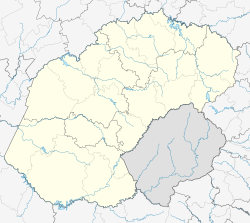
Wildebeest, also called gnu, are antelopes of the genus Connochaetes and native to Eastern and Southern Africa. They belong to the family Bovidae, which includes true antelopes, cattle, goats, sheep, and other even-toed horned ungulates. There are two species of wildebeest: the black wildebeest or white-tailed gnu, and the blue wildebeest or brindled gnu.
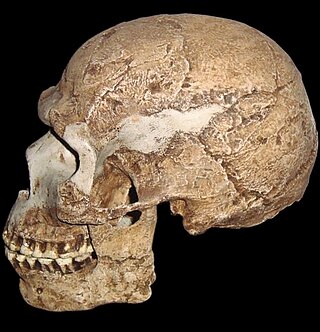
Early modern human (EMH), or anatomically modern human (AMH), are terms used to distinguish Homo sapiens that are anatomically consistent with the range of phenotypes seen in contemporary humans, from extinct archaic human species. This distinction is useful especially for times and regions where anatomically modern and archaic humans co-existed, for example, in Paleolithic Europe. Among the oldest known remains of Homo sapiens are those found at the Omo-Kibish I archaeological site in south-western Ethiopia, dating to about 233,000 to 196,000 years ago, the Florisbad site in South Africa, dating to about 259,000 years ago, and the Jebel Irhoud site in Morocco, dated about 315,000 years ago.
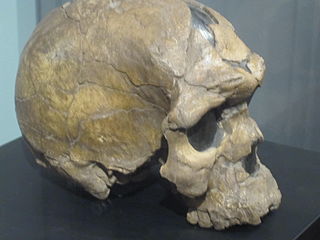
Herto Man refers to human remains discovered in 1997 from the Upper Herto member of the Bouri Formation in the Afar Triangle, Ethiopia. The remains have been dated as between 154,000 and 160,000 years old. The discovery of Herto Man was especially significant at the time, falling within a long gap in the fossil record between 300 and 100 thousand years ago and representing the oldest dated H. sapiens remains then described.

The Max Planck Institute for Evolutionary Anthropology is a research institute based in Leipzig, Germany, that was founded in 1997. It is part of the Max Planck Society network.
Brandfort, officially renamed Winnie Mandela in 2021, is a small agricultural town in the central Free State province of South Africa, about 60 km northeast of Bloemfontein on the R30 road. The town serves the surrounding farms for supplies and amenities. It is well known for once being home to the anti-apartheid stalwart and wife of Nelson Mandela, Winnie Mandela, during her banishment.
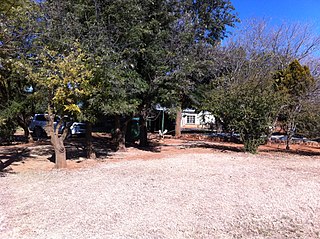
Dealesville is a mixed farming town in the Free State province of South Africa and is surrounded by numerous salt pans. There are many natural springs in the vicinity, most notably Florisbad some 35 km from the town.
The Omo remains are a collection of hominin bones discovered between 1967 and 1974 at the Omo Kibish sites near the Omo River, in Omo National Park in south-western Ethiopia. The bones were recovered by a scientific team from the Kenya National Museums directed by Richard Leakey and others. The remains from Kamoya's Hominid Site (KHS) were called Omo I and those from Paul I. Abell's Hominid Site (PHS) were called Omo II.
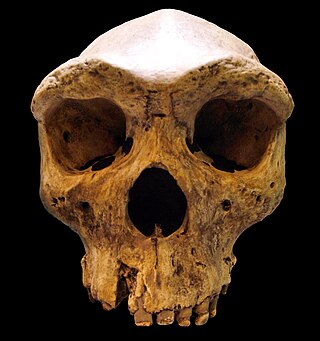
Archaic humans is a broad category denoting all species of the genus Homo that are not Homo sapiens. Among the earliest modern human remains are those from Jebel Irhoud in Morocco, Florisbad in South Africa (259 ka), and Omo-Kibish I in southern Ethiopia. Some examples of archaic humans include H. antecessor (1200–770 ka), H. bodoensis (1200–300 ka), H. heidelbergensis (600–200 ka), Neanderthals, H. rhodesiensis (300–125 ka) and Denisovans,

Aus is a settlement in the ǁKaras Region of southern Namibia. It lies on a railway line and the B4 national road, 230 km west of Keetmanshoop and about 125 km east of Lüderitz and belongs to the ǃNamiǂNûs electoral constituency. Trains from Keetmanshoop now end their journey at the village but formerly continued on to Lüderitz. The settlement is small but has a number of amenities including a hotel, police station, shop and garage. It is located in the Aus Mountains above the plains of the Namib Desert. The climate is usually hot and arid but snow has been recorded in the winter of 1963, and the area features the coldest winters recorded in Namibia.
The Florisbad archaeological and paleontological site is a provincial heritage site in Brandfort in the Free State province of South Africa. The most notable find at this site is the Florisbad Skull, the partial skull of an early human species that was discovered in 1932.

Olorgesailie is a geological formation in East Africa, on the floor of the Eastern Rift Valley in southern Kenya, 67 kilometres (42 mi) southwest of Nairobi along the road to Lake Magadi. It contains a group of Lower Paleolithic archaeological sites. Olorgesailie is noted for the large number of Acheulean hand axes discovered there that are associated with animal butchering. According to the National Museums of Kenya, the finds are internationally significant for archaeology, palaeontology, and geology.

The Florisbad Skull is an important human fossil of the early Middle Stone Age, representing either late Homo heidelbergensis or early Homo sapiens. It was discovered in 1932 by T. F. Dreyer at the Florisbad site, Free State Province, South Africa.

Smeringopus is a genus of cellar spiders that was first described by Eugène Louis Simon in 1890.
The term archaic Homo sapiens has different meanings depending on the preferred system of taxonomy. See Human taxonomy for the question of taxonomic classification of early human varieties.

The National Museum in Bloemfontein dates back to the 1870s, when its collections and displays comprised mainly rarities from around the world. It was established on 20 July 1877 and opened to the public on 20 May 1878. The old Raadsaal building was made available by the then Free State Volksraad for hosting the Museum collections. A new museum building was completed in 1913 and the official opening took place in 1915. Since 1881 the museum has been subsidised mainly by government. Through donations, purchases and exchange agreements the Museum’s collections slowly got established and grew to a wide variety of natural and human science artefacts.
The R700 is a regional route in Free State, South Africa that connects Hoopstad with Bloemfontein via Bultfontein and Soutpan.
The R703 is a regional route in Free State, South Africa that connects Dealesville with Clocolan via Brandfort, Verkeerdevlei and Excelsior.
Florisbad is a health resort 45 km northwest of Bloemfontein and 47 km south-west of Brandfort, near the Haagenstad salt-pan. Named after Floris Venter who opened up the mineral spring. Florisbad archaeological and paleontological site is now a tourist attraction.
Rastellus is a genus of African termite hunters first described by Norman I. Platnick & E. Griffin in 1990.
